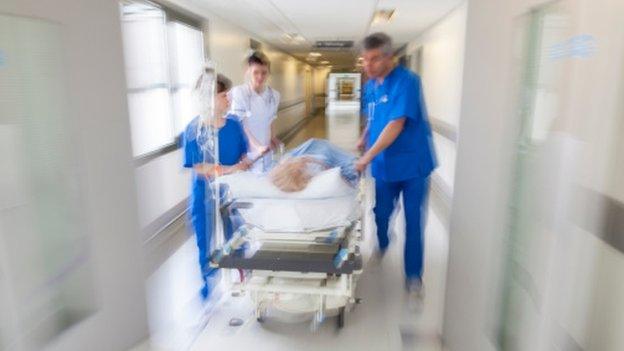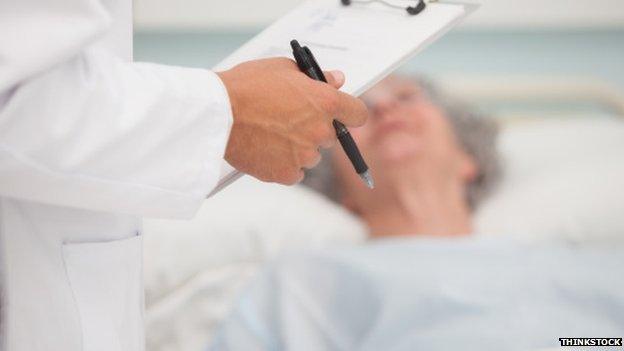A&E: Are we asking the right question?
- Published

A fifth of A&E patients are admitted to hospital
About 14m visits a year are made to major A&E units in England each year. With such mass attendance, it seems almost certain some will not be absolutely necessary.
The question being asked by the College of Emergency Medicine is exactly how many visits that actually is.
Research it has carried out suggests about 15% of patients could be seen elsewhere.
This contrasts with the 25% figure put forward by NHS England to justify its reorganisation of A&E units.
In fact, when the college first approached the BBC it was highlighting a 40% figure which has been bandied about by NHS England.
That refers to the proportion of patients who get no treatment during their time at A&E.
This prompted objections from NHS England that like for like figures were not being compared.
Just because a patient did not receive treatment, it does not mean their attendance was unnecessary.
Their symptoms - breathing difficulties for example - could have subsided or they may have been assessed and given advice by a specialist and then allowed to leave.
In the end, the college accepted the 25% figure as the best one to compare with its figure.
Nonetheless, this still amounts to a difference of 1.4m - a not insubstantial number when thinking about what to do to tackle pressures on A&E.
Nowhere else to go?

Many believe the number of elderly patients attending A&E could be cut
But are these figures actually important? In a way, no. Let me explain why.
It could be argued that the question that really matters is how many visits to A&E could have been prevented.
This may seem like semantics, but it isn't. A&E is the safety net for the system.
It is basically used for two reasons.
Either a patient has nowhere else they feel they can go or they have a genuine emergency.
The analysis done by the college is, essentially, looking at the first group.
But if we are trying to relieve the pressure on A&E, it is essential the second group is also considered.
About a fifth of visits to A&E end up in a patient being admitted to hospital.
These are the most serious, sometimes life-threatening, situations.
But of that figure, a fifth again are considered avoidable.
Return visits
That's not to say they shouldn't be there, but just that their "crisis" could have been prevented in the first place.
These could include an elderly patient who has had a fall or younger patient with an asthma attack.
It is a point made by Caroline Abrahams, of Age UK. She says: "We believe that many hospitals admissions of older people could be avoided with better prevention, care planning and proactive support, including greater access to social care and voluntary sector support at home."
Even among those who are not admitted to hospital, it is clear things could be improved.
Nearly one in 10 make a return visit to A&E within seven days. Some of these undoubtedly could be prevented.
Not all of this is the NHS's fault.
Some of it is related to how patients care for themselves.
But what it shows is that the potential for reducing visits to A&E is immense.